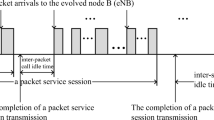Abstract
In order to minimize the power consumption of user equipments (UEs), and further to support various services and transmissions of large amount of data, the power saving mechanisms have been investigated for most remarkable wireless systems. In this paper, an improved dynamic discontinuous reception (D-DRX) scheme is presented for LTE system, which is able to adaptively adjust the inactivity timer and the sleep period of UEs’ receivers. Moreover, theoretical analysis based on the Markov chain is provided for the D-DRX scheme. Several numerical examples quantitatively show that the D-DRX scheme can capture various packet arrival patterns and scheduling behaviors of system to make a better tradeoff between power saving and packet delay by considering the length of packet queue.
Similar content being viewed by others
References
Tang Q L, Yang L Q, Qin T F, et al. Energy-saving PPM schemes for WSNs. Sci China Ser F-Inf Sci, 2007, 51: 571–585
Zhou P, Yao J H, Pei J L. Implementation of an energy-efficient scheduling scheme based on pipeline flux leak monitoring networks. Sci China Ser F-Inf Sci, 2009, 52: 1632–1639
3rd Generation Partnership Project: Technical Specification Group Radio Access Network. UE procedures in idle mode and procedures for cell reselection in connected mode. 3GPP TS 25.304, version 5.1.0, 2002
IEEE Standard for Local and Metropolitan Area Networks-Part 16: Air Interface for Fixed and Mobile Broadband Wireless Access Systems (802.16e). 2005
3rd Generation Partnership Project: Technical Specification Group Radio Access Network. Evolved universal terrestrial radio access (E-UTRA) and evolved universal terrestrial radio access network (E-UTRAN): Overall description. 3GPP TS 36.300, version 8.0.0, 2008
Yang S R, Lin Y B. Modeling UMTS discontinuous reception mechanism. IEEE Trans Wirel Comm, 2005, 4: 312–319
Yang S R, Yan S Y, Hung H N. Modeling UMTS power saving with bursty packet data traffic. IEEE Trans Mobile Comput, 2007, 6: 1398–1408
Yeh J H, Chen J C, Lee C C. Comparative analysis of energy saving techniques in 3GPP and 3GPP2 systems. IEEE Trans Veh Tech, 2009, 58: 432–448
Zhou L, Xu H B, Tian H, et al. Performance analysis of power saving mechanism with adjustable DRX cycles in 3GPP LTE. In: Proceedings of IEEE 68th VTC, San Antonio, TX, Piscataway, NJ, USA, 2008. 1457–1461
Xiao Y. Energy saving mechanism in the IEEE 802.16e wireless MAN. IEEE Commun Lett, 2005, 9: 595–597
Zhang Y, Fujise M. Energy management in the IEEE 802.16e MAC. IEEE Commun Lett, 2006, 10: 311–313
Guo K Q, Sun L X, Wang P, et al. Efficiency-aware and fairness-aware joint-layer optimization for downlink data scheduling in OFDM. Scin China Ser F-Inf Sci, 2008, 51: 171–182
3rd Generation Partnership Project Technical Specification Group Radio Access Network. Evolved universal terrestrial radio access (E-UTRA) medium access control (MAC) protocol specification. 3GPP TS 36.321, version 8.3.0.2008
Bontu C. Illidge E. DRX mechanism for power saving in LTE. IEEE Commun Mag, 2009, 47: 48–55
Xu H B, Tian H, Gao Y J, et al. QoS-oriented cross-layer resource allocation with finite queue in OFDMA systems. In: Proceedings of IEEE WCNC, Las Vegas, Nevada, USA, 2008. 1519–1524
Author information
Authors and Affiliations
Corresponding author
Rights and permissions
About this article
Cite this article
Xu, H., Tian, H., Huang, B. et al. An improved dynamic user equipment power saving mechanism for LTE system and performance analysis. Sci. China Inf. Sci. 53, 2075–2086 (2010). https://doi.org/10.1007/s11432-010-4069-7
Received:
Accepted:
Published:
Issue Date:
DOI: https://doi.org/10.1007/s11432-010-4069-7




